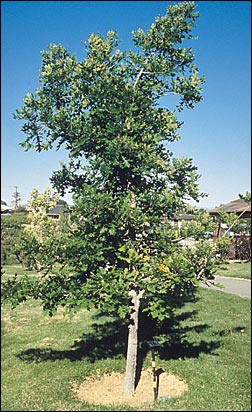
Oaks are generally very tall growing deciduous trees (50-75 ft.) of varying widths, so they require adequate room to develop and should not be considered for a small yard. They are tolerant of heat, wind, cold and drought. Plant in full sun, well-drained soil and water deeply once every 10-14 days. Do not overwater oaks as they are prone to root rot in wet soils. These trees are a valuable food source for rabbits and squirrels. Not temperature sensitive or disease prone. Does not need protection.
- Q. acutissima (Sawtooth Oak) 40 ft. tall by 30 ft. wide; linear leaf with serrated edges; no fall color
- Q. alba (White Oak) 75 ft. tall by 75 ft. wide; dark green leaves turning red-purple in fall
- Q. bicolor (Swamp White Oak) 50 ft. tall by 50 ft. wide; tolerates wet soil; yellow, brown and red fall colors
- Q. douglasii (Blue Oak) 50 ft. tall by 50 ft. wide; blue-green leaves turn pink, orange, yellow in fall
- Q. lobata (Valley Oak) 75 ft. tall by 75 ft. wide; 4 in. green leaves; no fall color
- Q. macrocarpa (Bur Oak) 60 ft. tall by 30 ft. wide; 8 in. green leaves; no fall color
- Q. palustris (Pin Oak) 75 ft. tall by 40 ft. wide; pyramid shape; no fall color; needs acid fertilizer
- Q. robur (English Oak) 100 ft. tall by 75 ft. wide; dark green leaves; no fall color
- Q. robur Fastigiata (Columnar English Oak) 75 ft. tall by 25 ft. wide; good substitute
for Lombardy Poplar - Q. rubra (Red Oak) 75 ft. tall by 50 ft. wide; shiny green leaves; red fall color
- Q. alba x robur (Crimson Spire Oak) This tree is a hybrid of white oak and English oak, with the best qualities of both. Crimson Spire can tolerate salty soil and likes full sun. As with the other oaks, this species can tolerate hot temperatures and wind and is very drought tolerant at maturity.
- Q. borealis
- Q. cocinea (Scarlet Oak)
- Q.macrocapa (Bur Oak) Well adapted to urban sites. The bur oak has a very interesting bark with deep fissures. 60 ft. tall by 30 ft. wide with leaves that get toe 8-10 inches long. These tress produce acorns that wildlife enjoy. A slow grower that is very drought tolerant and can stand soil from acid to alkaline.
- Q. robur ‘fastigiata’ (English Oak) 75ft tall by 25ft wide; good substitute for Lombardy Poplar. Not as popular and other oaks, this tree is a good choice for the Truckee Meadows. The leaves are smaller than on the bur oak, approximately 5 inches. This tree is dought tolerant, adapts to poor soil and likes full sun.
- Q. robur (Skymaster) This tree has a strong central leader and wide crotch angles making it able to withstand high winds. A medium water user that is disease and pest resistant. This tree has been developed specifically to be a street tree; begins life in a narrow shape and becomes pyramidal at maturity.
- Q. robur (Skyrocket) A great selection for narrow areas, this tree only gets 15′ wide at maturity. The leaves are dark green with the typical oak shape, turning bright yelow in fall. Water needs are medium to low.
